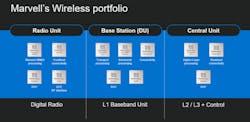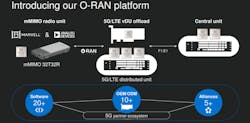Marvell Expands Chip Lineup for Open-Standard 5G Base Stations
Marvell Technology introduced a new baseband processor and a complete set of blueprints for building the chips into base stations based on an emerging open-source standard for 5G radio access networks.
The Santa Clara, California-based company last month rolled out a new category of the Octeon Fusion chips it sells to leading telecom gear manufacturers, including Nokia and Samsung—the Octeon Fusion-O chip. Marvell said the chip meets a new 5G standard called Open RAN, for open radio access networks. Open RAN separates out the components of base stations, making all the parts more interchangeable and allowing telecoms to scale 5G networks faster and more cheaply.
Base stations are a set of boxes installed on top of towers or buildings to connect smartphones and other devices to cellular networks. The boxes are largely sold by telecom equipment giants, such as Huawei Technologies, Ericsson, Nokia, Cisco Systems, and others as all-in-one systems, each with proprietary packages of hardware and software that clash with products rolled out by other firms.
The standard would serve as a software interface for all the subsystems in 5G base stations, giving customers the ability to mix and match the baseband, radio, and other components from a range of vendors. The open RAN technology also promises to be cheaper than the end-to-end systems made by current firms and linked together with custom interfaces, giving customers the flexibility to add new features to their 5G networks by upgrading software or swapping out industry-standard chips.
The Open RAN standard creates "functional splits" between the subsystems in the base station. The radio unit, or RU, is used to manage the radio frequency, or RF, functions in 5G networks and process, condition, and amplify signals, including millimeter waves that deliver very high transmission speeds over short distances. The distributed unit, or DU, is used to perform the baseband processing for 5G.
The other major component of 5G networks is the central unit, which can be co-located with the DU in compact servers close to the cellular antennas or isolated in a telecom's cloud, where it is used to run the core management and control functions for 5G networks. The DU and CU are the computational parts of the base station, while the RU is located close to—or integrated into—the cellular antenna.
For 5G networks using this modular architecture, Marvell has introduced a set of reference designs that serve as blueprints for building its Octeon Fusion-O baseband processors and other networking chips into radio, distributed, and centralized units. Marvell also plans to roll out software as part of a package with its hardware, making it easier for OEMs to build new base stations from the ground up.
Marvell said the Octeon Fusion-O chip incorporates the core capabilities of the base part and builds in improvements for O-RAN systems. One of these optimizations is support for the enhanced common public radio interface, or CPRI, that serves as a general-purpose interface between the base station's radio heads and the servers that are used to perform baseband processing and run other workloads.
Traditional "closed" networks use CPRI interfaces to link together the base station. But each telecom gear maker implements a slightly different style, making the hardware incompatible with other firms'.
Last year, the Silicon Valley vendor rolled out its latest generation of Octeon Fusion chips for 5G. The chips integrate Arm CPU cores, programmable DSP cores and baseband and fronthaul accelerators ideal for 5G networks that support far faster data transfers than the 4G technology today. The chips accommodate up to 100 Gbps Ethernet while the memory subsystem stocks up to 3.5 MB of cache.
According to Marvell, the chips are ideal for massive MIMO radios that rely on large antenna arrays to send radio signals in concentrated jets to different devices at the same time, instead of blanketing the area in a wide cone like a floodlight. The Octeon Fusion-O also brings the compute power needed for the underlying beamforming technology, which helps bolster the overall throughput and speed of 5G.
Marvell also rolled out a reference design for an advanced 5G radio solution it designed with Analog Devices. The RU integrates Marvell's Octeon Fusion-O with Analog Devices' RF CMOS technology.
The Silicon Valley-based company plans to roll out the Octeon Fusion-O family of chips as standalone parts for base stations that use Open RAN technology to separate the RU and DU. Marvell also plans to offer them as accelerator cards that slot into off-the-shelf servers that can be located a long distance from the base station’s radio heads to offload core network functions.
Marvell said the Octeon Fusion-O chips are used to perform physical layer (PHY)—called Layer 1—protocols in real time in the radio and baseband portions of 5G telecom gear. The company also sells its Octeon TX processors to handle networking chores—Layer 2 and Layer 3 protocols—that coordinate data transfers between nodes on the same 5G network and from network to network.
Marvell said Octeon is one of the industry's leading data processing units (DPUs), with up to 36 Arm 64-bit CPU cores with programmable accelerator blocks that can deliver up to 200-Gbps of throughput.
Marvell is trying to take on the likes of Intel and Qualcomm—and indirectly, the proprietary chips of base station vendors—in the arms race for 5G base station chips. Qualcomm, the world's largest vendor of smartphone modems, plans to start supplying its first generation of 5G RAN silicon by 2022. Intel has ambitions to become the global leader with 40% market share by the end of 2021.
Marvell said its Open RAN platform provides a purpose-built, highly programmable solution to address the capacity, power, cost, and time-to-market challenges presented by current 5G architectures. Today, telecom manufacturers use FPGA- or GPU-based PHY acceleration to build and test out 5G base stations. But according to Marvell, these solutions come with cost and power compromises.
Additionally, the company also rolled out a new Ethernet switch chip, the Prestera DX 7300, that is designed to be used as a component of disaggregated 5G O-RAN systems and reference designs.
The O-RAN standard uses software to guarantee all the components can work together, mirroring so-called "white box" systems used in software-defined networks that dominate cloud data centers. The strategy is to replace the proprietary equipment used in the sprawling networks in data centers with cheap, commodity gear. That helped reduce costs for cloud providers and other technology giants.
Open radio access network hardware is projected to be 10% of the total 5G infrastructure market and account for around $5 billion in global sales by 2025, according to market research firm Dell Oro Group.
“Marvell has long been a leading supplier of RAN technology to telecom OEMs,” said Earl J. Lum, technology analyst at EJL Wireless Research, in a statement. “Whether Open RAN or traditional integrated RAN, the processing requirements never change, it is just a matter of where all the processing occurs as the RAN becomes disaggregated, virtualized and more open," he said.
Marvell said that development kits for its new O-RAN platform would be available in early 2021.
About the Author
James Morra
Senior Editor
James Morra is the senior editor for Electronic Design, covering the semiconductor industry and new technology trends, with a focus on power electronics and power management. He also reports on the business behind electrical engineering, including the electronics supply chain. He joined Electronic Design in 2015 and is based in Chicago, Illinois.




